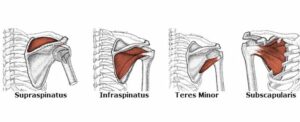Rotator Cuff Muscle and Rotator Cuff Injury
Rotator cuff muscle
The rotator cuff muscle is actually not one muscle but four muscles that all act together to help stabilize our shoulder. The shoulder(glenohumeral joint) is a multi axial joint meaning it can move in multiple directions with stabilization provided by our ligaments, shoulder capsule, and the rotator cuff muscles. Here are the four muscles and the actions they provide:
1. Supraspinatus – shoulder abduction (eg. raising your arm at your side)
2. & 3. Infraspinatus and teres minor – shoulder external rotation (eg. rotating shoulder back when you throw a ball)
4. Subscapularis – shoulder internal rotation (eg. placing hand on belly)

Shoulder Injury
You can have an overuse (tendinopathy) injury to one of your shoulder muscle(s) or most commonly a muscle tear (strain). The risk of injury increases with age from 9.7% those <20 years to 62% in 80+ year olds. Both tendinopathies and strains can be diagnosed by your physiotherapist. Usually if there is a suspected strain (tear) the physio may send you in for a scan to see how big the tear is. Tears are classified by the National Health Service in England as:
-Small (less than 1cm)
-Medium (1-3cm)
-Large (3-5cm)
-Massive (over 5cm)
Once the physio gets the report they may send you for a consultation with a surgeon if the tear is 3cm or greater to get further guidance for better prognosis. If you have had already had a surgery or are waiting on one, a physio can help you regain functionality during post-op recovery under the guidance of your surgeon.
If you have any concerns about your shoulders, have a shoulder injury, or just want a bit more help finding out how to strengthen your shoulders our physios would be happy to help. Book an appointment HERE.
By Physiotherapist, Paulina Backiel
References
1.May T, Garmel GM. Rotator Cuff Injury. In: StatPearls. StatPearls Publishing, Treasure Island (FL); 2020. https://europepmc.org/article/nbk/nbk547664#free-full-text
2.Scott-Dempster, Claire. “Outpatient Post-Operative Physiotherapy guidelines.” NHS Foundation Trust, August 2019. https://www.ouh.nhs.uk/shoulderandelbow/information/documents/rotator-cuff-repair.pdf
3. Photo retrieved from https://bodyharmonics.com/wp-content/uploads/2015/05/Rotator-Cuff-Muscles.jpg
Related Articles
May
May
Apr